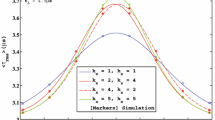Abstract
A new analytical statistical model has been developed in order to describe the self-interference that results due to multipath propagation in a BPSK spread spectrum system. Motivation for this work was the fact that the well-known Gaussian approximation that has been extensively used in the past in order to describe such terms is not satisfactory, especially when the probability of error is smaller than10−2 or 10−3. The existence of two paths inthe radio channel has been assumed. The amplitude of each path has been assumed as Rayleigh distributed while the arrival time of the second path with respect to the arrival time of the first one has been assumed to be uniformly distributed. The validity of the developed model has been examined by comparing analytical results with results obtained by simulation using Monte Carlo techniques. Results taken from the Gaussian approximation were also compared with the simulation results. It was shown that the developed model describes with great accuracy the pre-mentioned undesirable term. On the contrary, the Gaussian approximation exhibits significant differences when compared to the simulation results. This is also evident by the use of a comparison parameter which is several orders of magnitude smaller for the developed model than for the Gaussian approximation (the smaller this parameter is the better the fit between two groups of data).
Similar content being viewed by others
References
K. Pahlavan and A. Levesque, Wireless Information Networks, John Wiley and Sons Inc.: New York, 1995.
R. Peterson, R. Ziemer and D. Borth, Introduction to Spread Spectrum Communications, Prentice Hall: New Jersey, 1995.
G. Eythymoglou, V. Aalo and H. Helmken, “Performance Analysis of Coherent DS-CDMA Systems in a Nakagami Fading Channel with Arbitrary Parameters”, IEEE Transactions on Vehicular Technology, Vol. 46, No. 2, pp. 289–297, 1997.
T. Eng and L. Milstein, “Coherent DS-CDMA Performance in Nakagami Multipath Fading”, IEEE Transactions on Communications, Vol. 43, No. 2/3/4, pp. 1134–1143, 1995.
H. Xiang, “Binary Code-Division Multiple-Access Systems Operating in Multipath Fading, Noisy Channels”, IEEE Transactions on Communications, Vol. 33, No. 8, pp. 775–784, 1985.
Y. Yoon, R. Kohno and H. Imai, “A Spread-Spectrum Multiaccess System with Cochannel Interference Cancellation for Multipath Fading Channels”, IEEE Journal on Selected Areas in Communications, Vol. 11, No. 7, pp. 1067–1075, 1993.
Y. Sanada and Q. Wang, “A Cochannel Interference Cancellation Technique Using Orthogonal Convolutional Codes on Multipath Rayleigh Fading Channels”, IEEE Transactions on Vehicular Technology, Vol. 46, No. 1, pp. 114–128, 1997.
G. Mazzini and V. Tralli, “Performance Evaluation of DS-CDMA Systems on Multipath Propagation Channels with Multilevel Spreading Sequences and Rake Receivers”, IEEE Transactions on Communications, Vol. 46, No. 2, pp. 244–257, 1998.
J. Holtzmann, “A Simple, Accurate Method to Calculate Spread-Spectrum Multiple-Access Error Probabilities”, IEEE Transactions on Communications, Vol. 40, No. 3, pp. 461–464, 1992.
R. Morrow and J. Lehnert, “Bit-to-Bit Error Dependence in Slotted DS/SSMA Packet Systems with Random Signature Sequences”, IEEE Transactions on Communications, Vol. 37, No. 10, pp. 1052–1061, 1989.
M. Pursley, “Performance Evaluation for Phase-Coded Spread-Spectrum Multiple-Access Communication-Part I: System Analysis”, IEEE Transactions on Communications, Vol. 25, No. 8, pp. 795–799, 1977.
F.M. Ozluturk, S. Tantaratana and A.W. Lam, “Performances of DS/SSMA Communications with MPSK Signaling and Complex Signature Sequences”, IEEE Transactions on Communications, Vol. 43, No. 2/3/4, pp. 1127–1133, 1995.
J. Lehnert and M. Pursley, “Error Probabilities for Binary Direct-Sequence Spread-Spectrum Communications with Random Signature Sequences”, IEEE Transactions on Communications, Vol. 35, No. 1, pp. 87–98, 1987.
H. Hashemi, “The Indoor Radio Propagation Channel”, in Proceedings of the IEEE, Vol. 81, No. 7, pp. 943–968, 1993.
A.F. Molisch, “Statistical Properties of the RMS Delay-Spread of Mobile Radio Channels with Independent Rayleigh-Fading Paths”, IEEE Transactions on Vehicular Technology, Vol. 45, No. 1, pp. 201–205, 1996.
K.H. Tsioumparakis, T.L. Doumi and J.G. Gardiner, “Delay Spread Statistics in Vicinity of Same Frequency Repeater”, Electronics Letters, Vol. 31, No. 18, pp. 1607–1609, 1995.
K.H. Tsioumparakis, T.L. Doumi and J.G. Gardiner, “Delay-Spread Considerations of Same-Frequency Repeaters in Wideband Channels”, IEEE Transactions on Vehicular Technology, Vol. 46, No. 3, pp. 664–675, 1997.
K.H. Tsioumparakis, T.L. Doumi and J.G. Gardiner, “Delay Spread Statistics in a Two-Path Radio Environment”, in Proc. 96th IEEE Conf. Vehicular Technology, pp. 642–646, 1996.
G.A Dimitrakopoulos and C.N. Capsalis, “An Analytical Statistical Model for the RMS Delay Spread Parameter in Millimeter Frequencies”, The International Journal of Infrared and Millimeter Waves, Vol. 18, No. 6, pp. 1335–1351, 1997.
G.A Dimitrakopoulos and C.N. Capsalis, “Statistical Modeling of RMS-Delay Spread under Multipath Fading Conditions in Local Areas”, IEEE Transactions on Vehicular Technology, Vol. 49, No. 5, pp. 1522–1528, 2000.
A. Papoulis, Probability, Random Variables and Stochastic Processes, 3rd edn, McGraw-Hill: California, 1991.
G. Cooper, Modern Communications and Spread Spectrum, McGraw-Hill: California, 1986.
Author information
Authors and Affiliations
Corresponding author
Rights and permissions
About this article
Cite this article
Dimitrakopoulos, G., Capsalis, C. Analytical Description of Self-Interference in Direct Sequence Spread Spectrum Communications. Wireless Personal Communications 27, 267–292 (2003). https://doi.org/10.1023/B:WIRE.0000012241.39064.aa
Issue Date:
DOI: https://doi.org/10.1023/B:WIRE.0000012241.39064.aa




